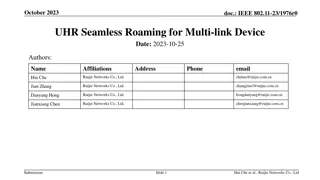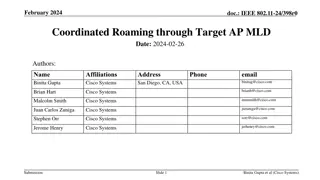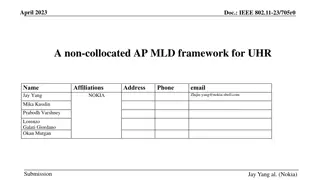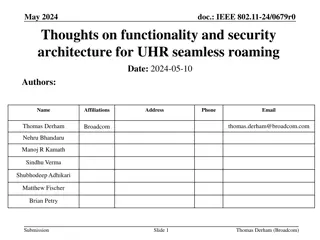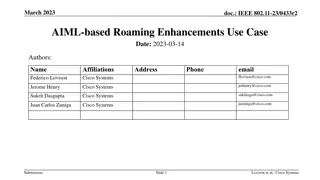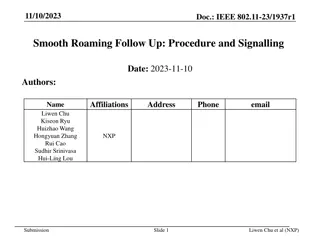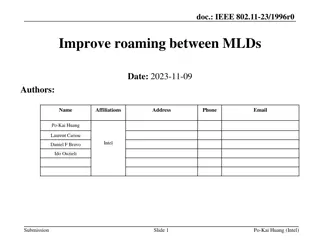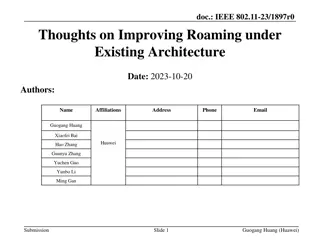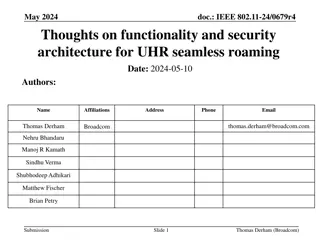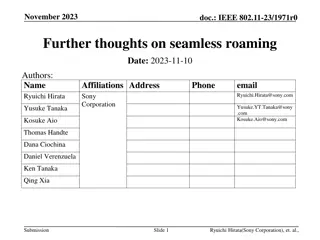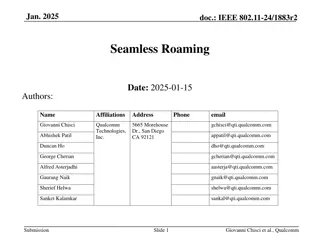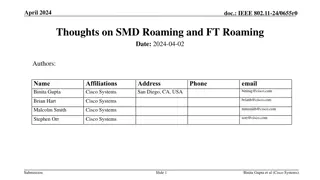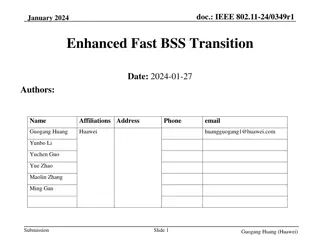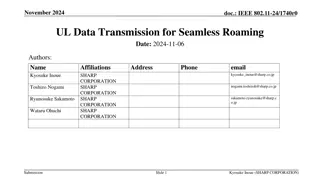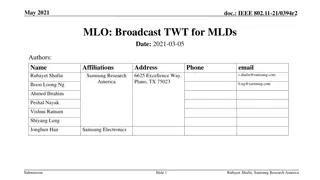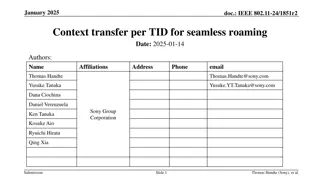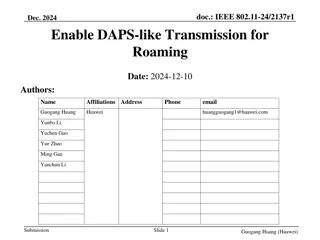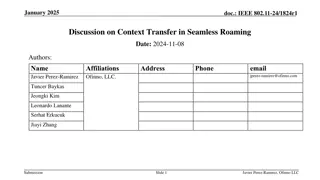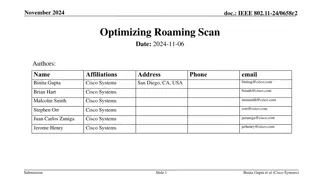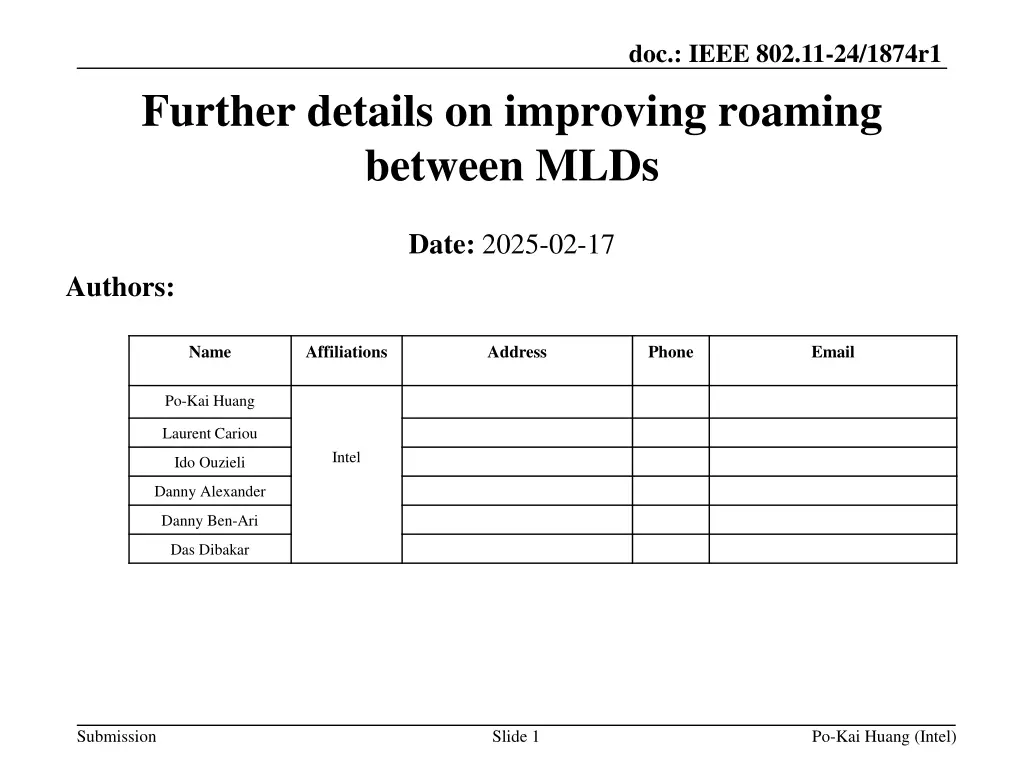
Improving Roaming Efficiency in Wireless Networks
Explore enhancements in roaming mechanisms for seamless transitions between Multiple Link Destinations (MLDs) in IEEE 802.11 networks, focusing on optimizing data exchange and minimizing downtime during roaming execution.
Download Presentation

Please find below an Image/Link to download the presentation.
The content on the website is provided AS IS for your information and personal use only. It may not be sold, licensed, or shared on other websites without obtaining consent from the author. If you encounter any issues during the download, it is possible that the publisher has removed the file from their server.
You are allowed to download the files provided on this website for personal or commercial use, subject to the condition that they are used lawfully. All files are the property of their respective owners.
The content on the website is provided AS IS for your information and personal use only. It may not be sold, licensed, or shared on other websites without obtaining consent from the author.
E N D
Presentation Transcript
doc.: IEEE 802.11-24/1874r1 Further details on improving roaming between MLDs Date: 2025-02-17 Authors: Name Affiliations Address Phone Email Po-Kai Huang Laurent Cariou Intel Ido Ouzieli Danny Alexander Danny Ben-Ari Das Dibakar Submission Slide 1 Po-Kai Huang (Intel)
doc.: IEEE 802.11-24/1874r1 Abstract There have been many options that are proposed to UHR roaming In this presentation, we focus on a specific scenario based on SMD with DS mapping change A common use case for general implementation Can be justified to have improvements compared with existing roaming scheme Flow already agreed in SFD Submission Slide 2 Po-Kai Huang (Intel)
doc.: IEEE 802.11-24/1874r1 Illustration of the common use case Current AP MLD Current AP MLD Target AP MLD Target AP MLD Non-AP MLD Non-AP MLD Roaming Preparation Request Context transfer Roaming Execution Request Roaming Execution Request Context transfer DL Data DL Data DL Data DL Data Transient period Transient period DL Data DL Data UL DATA UL DATA DL DATA DL DATA With preparation, the best strategy is to finish all the contexts transfer during preparation to minimize exchange time of roaming execution Not listing data forwarding due to unpredictable support/backhaul on AP MLD During transient period non-AP MLD can switch to target AP MLD for data exchange, but due to single radio constraints, the best strategy is to finish DL data with current AP MLD ASAP without switching back and forth Slide 3 Submission Po-Kai Huang (Intel)
doc.: IEEE 802.11-24/1874r1 Gains compared with existing Roaming Current AP MLD Current AP MLD Target AP MLD Target AP MLD Non-AP MLD Non-AP MLD Roaming Preparation Request Context transfer Roaming Execution Request Roaming Execution Request Context transfer DL Data DL Data DL Data DL Data Transient period Transient period DL Data DL Data UL DATA UL DATA DL DATA DL DATA Enable data exchange after roaming without additional frame exchange due to context transfer Minimize pause time of roaming execution exchange due to preparation finishing all context transfer Transient period to finish remaining DL data of current AP MLD if desired without loss Continue UL data without loss and avoid UL data duplicate Slide 4 Submission Po-Kai Huang (Intel)
doc.: IEEE 802.11-24/1874r1 Simplify the preparation operation Current AP MLD Target AP MLD Non-AP MLD Roaming Preparation Request Context transfer timeout Roaming Execution Request Roaming preparation request only focus on one target AP MLD A SMD unified timeout indicated in initial connection Already the case for FT reassociation deadline Non-AP MLD knows the time beforehand to send roaming execution request Target AP MLD deletes preparation information if no follow up after timeout No Target AP MLD setup link change until roaming execution exchange is finished Roaming execution request is not rejected if preparation beforehand Submission Slide 5 Po-Kai Huang (Intel)
doc.: IEEE 802.11-24/1874r1 Simplify the transient period operation Non-AP MLD Roaming Preparation Request Current AP MLD Target AP MLD Context transfer Roaming Execution Request DL Data DL Data Transient period DL Data All the information in reassociation request frame needs to be in roaming preparation request or roaming execution request Including listen interval for beacon wakeup However, requirement to listen Beacon of target AP MLD needs to be suspended during transient period to avoid switching back and forth for single radio non-AP MLD Setup links with target AP MLD also needs to be in power save mode by default Slide 6 Submission Po-Kai Huang (Intel)
doc.: IEEE 802.11-24/1874r1 When the transient period ends? Non-AP MLD Current AP MLD Target AP MLD Roaming Execution Request DL Data DL Data Timeout Transient period DL Data Early termination frame A timeout indicated in roaming execution response Indication through More Data bit to know if there are existing data even in Active mode Early termination frame from non-AP MLD when DL data is finished early or needs to go to target AP MLD Submission Slide 7 Po-Kai Huang (Intel)
doc.: IEEE 802.11-24/1874r1 Minimal Context Transfer for Data Operations UL/DL BA parameters Avoid ADDBA exchange Next PN for DL Security requirement and can be done with big gap Latest UL forward up SN Avoid duplicate and can be sent to non-AP MLD during roaming execution All relevant UL replay counters Avoid replay Client can indicate next UL PN to target AP MLD to help How about DL SN? DL SN is required if having DL data from target AP MLD during transient period If can not reliability support due to dynamic nature, then capability indication from AP MLD Submission Slide 8 Po-Kai Huang (Intel)
doc.: IEEE 802.11-24/1874r1 Conclusion We discuss the important proposals for the following common scenario Current AP MLD Current AP MLD Target AP MLD Target AP MLD Non-AP MLD Non-AP MLD Roaming Preparation Request Context transfer Roaming Execution Request Roaming Execution Request Context transfer DL Data DL Data DL Data DL Data Transient period Transient period DL Data DL Data UL DATA UL DATA DL DATA DL DATA Submission Slide 9 Po-Kai Huang (Intel)
doc.: IEEE 802.11-24/1874r1 Straw Poll Do you support the following for roaming preparation request/response exchange? - After the roaming preparation request/response exchange, there is an indicated timeout o If there is no successful transmission of the roaming execution request frame from the non-AP MLD within the indicated timeout, then the target AP MLD may delete all preparation information related to the non-AP MLD NOTE - This includes security context, i.e., new derived TK if new TK is derived o if the roaming preparation request for a target AP MLD is accepted in the roaming preparation response, and the non-AP MLD sends a following roaming execution request for the target AP MLD received within the indicated timeout, then the roaming execution request shall be accepted in the roaming execution response o TBD on indication of the timeout - After the latest roaming preparation request/response exchange, the setup links with the target AP MLD is not modified until after the roaming execution request/response exchange is finished. Submission Slide 10 Po-Kai Huang (Intel)
doc.: IEEE 802.11-24/1874r1 Straw Poll Do you support the following for roaming preparation request/response exchange? There is only one target AP MLD indicated in the roaming preparation request frame from a non-AP MLD Submission Slide 11 Po-Kai Huang (Intel)
doc.: IEEE 802.11-24/1874r1 Straw Poll Do you support the following? The roaming preparation request frame includes Listen Interval field of the non-AP MLD for the target AP MLD The roaming execution request frame includes Listen Interval field of the non-AP MLD for the target AP MLD if there is no roaming preparation request/response exchange beforehand After the roaming execution request/response exchange with the current AP MLD, the non-AP MLD is by default in power save mode for all the setup links with the target AP MLD After the roaming execution request/response exchange with the current AP MLD, during the TBD period to receive DL data from the current AP MLD, the non-AP MLD is not required to listen to any Beacon frames of the APs affiliated with the target AP MLD Submission Slide 12 Po-Kai Huang (Intel)
doc.: IEEE 802.11-24/1874r1 Straw Poll Do you support that after the roaming execution request/response exchange with the current AP MLD, the TBD period to receive DL data from the current AP MLD ends after the indicated timeout in the roaming execution response? Submission Slide 13 Po-Kai Huang (Intel)
doc.: IEEE 802.11-24/1874r1 Straw Poll Do you support to enable the following contexts to be transferred to target AP MLD to preserve the data exchange context for the non-AP MLD? Block Ack Parameters and Block Ack Timeout Value indicated by the non-AP MLD for existing BA agreement of a TID Next SN to be assigned for DL individually addressed data frame of each TID Latest duplicate receiver cache for TID without BA agreement latest SN that has been pass up for TID with UL BA agreement Starting PN to be assigned for DL individually addressed frame by the target AP MLD Initial value to be used by each replay counter of the target AP MLD for UL individually addressed frame WinStartO of an existing DL BA agreement so that the target AP MLD does not exceed reordering buffer window of the non-AP MLD TBD for other contexts Submission Slide 14 Po-Kai Huang (Intel)

